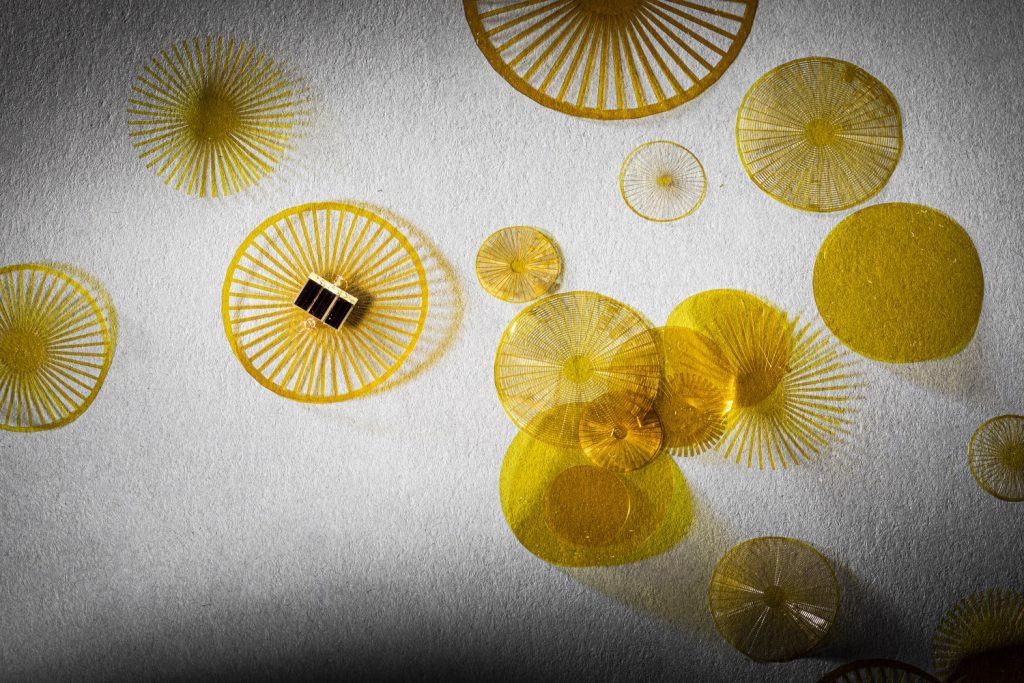Wireless sensors have wide-ranging potential across diverse application areas, including agriculture, environmental sciences, medical sciences, telecommunications, surveillance, amongst others.
 The researchers tested 75 designs, some of which are shown here in yellow. Image Credit: Mark Stone/University of Washington
The researchers tested 75 designs, some of which are shown here in yellow. Image Credit: Mark Stone/University of Washington
The scope of application is due to the fact that wireless sensors are designed to measure specific parameters in their physical surroundings and supply outputs, typically electrical signals, for additional processing. These parameters include various types of stimuli, including temperature, humidity, lighting levels, movements and liquid leakages across large areas of land.
This makes wireless sensor technology particularly attractive to those working in agriculture and the environmental sciences, as wireless sensing devices can offer access to unique insights and information to improve industrial practices and monitor a changing climate. However, it can be costly and labor-intensive to physically install large numbers of sensors across a vast swathe of land.
Now, a team of researchers at the University of Washington (UW) has drawn inspiration from nature to develop battery-free, minute-sensor-carrying devices that could help distribute wireless sensors across large areas.
The UW researchers published their work in the journal Nature, which explains how the device was created using standard, readily available stock components.
Battery-Free Wind Dispersal
Encouraged by the way dandelions use wind currents to disperse their seeds, the device is released by a drone and can travel up to 100 meters on a mild breeze. Once settled in position, the novel, battery-free device has the ability to transmit data from the sensors over 60 meters using tiny solar panels to power its integrated electronic system.
Our prototype suggests that you could use a drone to release thousands of these devices in a single drop. They’ll all be carried by the wind a little differently, and basically you can create a 1,000-device network with this one drop.
Shyam Gollakota, UW professor in the Paul G. Allen School of Computer Science & Engineering
This could be a significant, transformational development for the field of deploying sensors because, as it stands, it can take weeks, maybe months, to deploy such a large number of sensors manually. Although, the team did have to overcome some serious challenges in order to make the system lightweight enough to carry on moderate winds.
The system remains heavier than a typical dandelion seed, but through innovation on model shapes and various rounds of testing, the team was able to determine what form factor would be most suitable to allow the devices to float on a breeze and travel across sufficient distances.
The way dandelion seed structures work is that they have a central point and these little bristles sticking out to slow down their fall. We took a 2D projection of that to create the base design for our structures.
Vikram Iyer, UW assistant professor in the Allen School
After testing over 75 designs, the team determined that adding a ring structure to the device added much-needed rigidity and allowed the system to slow down with an increased surface area.
The use of solar panels rather than batteries keeps the overall weight of the structure down and in testing, the device was 95% effective at landing the right way up.
Power Consumption and Data Transmission
However, the use of lightweight solar panels also means that there is no capacity for energy storage, so the devices remain 100% dependent on a constant source of light, meaning they do not transmit data overnight.
The team designed the electronics to include a device that can store some energy overnight, called a capacitor, making the devices more efficient at powering on when returned to a light source.
These wireless devices rely on backscatter, a method that sends information by reflecting transmitted signals, to wirelessly transmit sensor data back to the research team. Backscatter systems transmit using reflected signals rather than generating radio frequency transmissions.
Resultingly, the power needed to communicate is significantly reduced because generating high-frequency RF signals can be the most power-consuming component of such a system.
The sensor-carrying devices were able to measure temperature, humidity, pressure and light while effectively broadcasting the data until they turned off once the sun had set. Data harvesting resumed the next morning at sunrise when the devices were able to turn themselves back on and resume service
The UW researchers will now continue to develop their system and address other challenges, such as creating biodegradable components that do not negatively impact natural ecosystems while harnessing the advantages of a battery-free system that will only stop working in the event of system or component failure.
References and Further Reading
Iyer, V., Gaensbauer, H., Daniel, T. and Gollakota, S., (2022) Wind dispersal of battery-free wireless devices. Nature, [online] 603(7901), pp.427-433. Available at: https://www.nature.com/articles/s41586-021-04363-9
McQuate, S., (2022) Tiny battery-free devices float in the wind like dandelion seeds. [online] Available at: https://www.washington.edu/news/2022/03/16/battery-free-devices-float-in-wind-like-dandelion-seeds/
Disclaimer: The views expressed here are those of the author expressed in their private capacity and do not necessarily represent the views of AZoM.com Limited T/A AZoNetwork the owner and operator of this website. This disclaimer forms part of the Terms and conditions of use of this website.